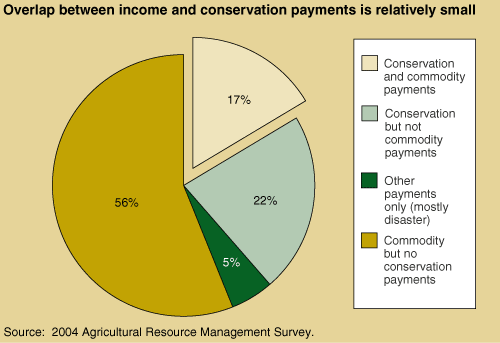Green Payments: Can Income and Conservation Payments Be Combined?
- by Roger Claassen
- 2/1/2007
'Green payments,' if enacted, would merge farm income support and conservation payments. Achieving both objectives with a single payment, however, assumes that farms targeted for income support also face pressing environmental concerns. If income support and conservation payments would otherwise go to different farms, policymakers will face tradeoffs between the two objectives when designing a green payments program.
Of the roughly 40 percent of farms that received some type of government payment in 2004, 17 percent—or about 6 percent of all farms—received both types of payments, partly because less money is spent on conservation. In 2004, income support to farmers was nearly $8 billion, while conservation payments totaled about $2 billion. Conservation funding is rising, however, so the number of farms receiving both types of payments also is likely to rise. Nonetheless, about half of conservation payments made in 2004 went to farmers who also received income support, suggesting that a significant share of additional conservation payments will also flow to producers who do not receive income support.
Why is the overlap between income and conservation payments so small? At least part of the answer is that income support and conservation payments are triggered by different actions or conditions and tend to attract different producers. Income support goes mainly to farmers who produce major field crops, including corn, wheat, soybeans, and cotton. Farms receiving commodity payments account for 64 percent of crop production and 45 percent of livestock production. These producers are also likely to be engaged full-time in farming and have relatively large farms.
Since 1986, a large majority of conservation payments have been for land retirement, largely though the Conservation Reserve Program (CRP). A majority of CRP payments go to retired and part-time farmers who, on average, receive modest commodity payments. Since 2002, funding for “working land” (which remains in agricultural production) programs, such as the Environmental Quality Incentives Program (EQIP), has increased sharply. While evidence suggests that these payments are more likely to go to full-time farmers with larger farms, 60 percent of EQIP funding is set aside for livestock producers who may or may not also grow crops that qualify for commodity payments. So, the shift in funding to working land programs may or may not increase the overlap between commodity and conservation payments.
This article is drawn from:
- Claassen, R. & Morehart, M. (2006). Greening Income Support and Supporting Green. U.S. Department of Agriculture, Economic Research Service. EB-1.


